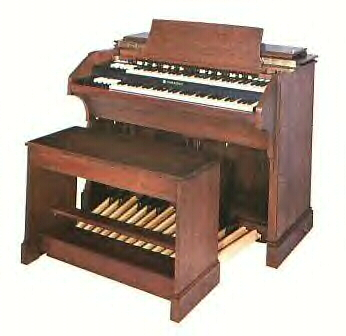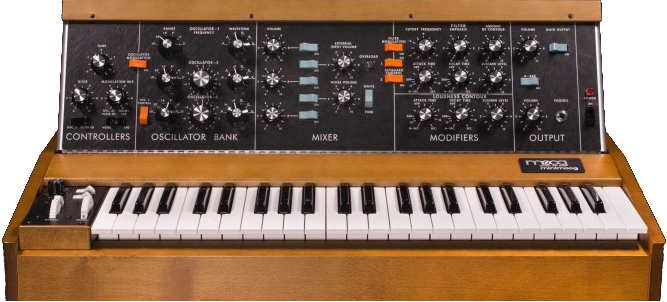A quick intro to the history of Analog Synthesizers
If you've ever tried a vintage analog synth, you know how well they can sound. From staring with a basic waveform, filtering it to get the perfect timbre, to modulate the sound, and making it shine, the journey can take you hours. But have you ever wondered why octave switches are named 16 / 8 / 4 and 2? or why are modules voltage-controlled instead of current controlled? In Digituria, we love the analog sound, so in this article, we will show you these little gems that make the history of the vintage synth sounds.
First electronic devices

The first electronic organs were introduced by Hammond in 1935. It consisted of two 5 octaves keyboard, had no velocity (it didn’t respond to how heavily or lightly the key was pressed), had no output envelope (pressing it resulted in the sound continuously playing until it was released) and the overall volume was controlled by a pedal.
They were not fully electronic, as they generated sound by rotating a metal tonewheel near an electromagnetic pickup but they have the cool feature that you could manipulate their sound and it was fully polyphonic: you could press all the keys at the same time and all will sound.
The sound on a tonewheel Hammond organ could be varied through the manipulation of drawbars. A drawbar was a fader that controlled the amplitude of a particular harmonic. A typical Hammond contained 9 drawbars: 16’ (sub-octave) 5 ⅓ (Quint) 8’ (Fundamental) 4’ (1 octave up) 2 ⅔’ 2’ (2 octaves) 1 ⅗‘ 1 ⅓’ and 1 (3 octaves up) The labeling of the drawbar derived from the pipe organs, in which the physical length of the pipe corresponds to the pitch produced: longer pipes produce lower-pitched notes, and shorter pipes are higher in pitch.
So this fully polyphonic instrument had two parts and was able to combine 8 oscillators per voice. Not even bad for today's standards!
Moog and the revolution of the analog synthesis

In the early ’60s, Bob Moog came to the scene. He started his business by manufacturing theremins. He wanted to provide more flexibility to the signal path, but working with electrical current made the process unreliable. So he quickly realized he had to switch to voltage-controlled devices. And that’s how his 3 major inventions kicked off the subtractive synthesis: The Voltage Controller Oscillator (VCO) The Voltage controller amplifier (VCA) and the Voltage Controller Filter (VCF). By making all the major params of the sound voltage controllable, he made it possible to create musical tones that were easily controlled, and modulable.
Notably, he created the 4-poles “ladder” filter that introduced new kinds of sound that were acclaimed until the present days. The creamy sounds of the filter are considered the best. Nowadays there are great VST emulations of the 4 poles ladder filter that models this characteristic sound.
In 1971, Bob released the Moog Model D (also known as Minimoog) that changed the landscape of analog synthesizers. The Model D consisted of 3 VCOs, plus one LFO, two envelopes (ADS), one wired to the VCF, and another to the VCA. This pre-wired circuitry allowed to simplify the usability for the musicians, and its relatively small size allowed it to be easily transported.
ARP Instruments
Alan Pearlman founded ARP Instruments in 1969 with his own funds, and his first instrument the ARP 2500 was released the next year. The success came with its second model: The ARP 2600, a semi-modular system that like the Moog Model D, came prewired making it ideal for musicians new to synthesis, due to its ability to be operated either with or without patch cords.
The ARP 2600 came with 3 VCOs with LFO capabilities. Pulse Width Modulation (PWM) option on oscillator 2, 2 Envelope Generators with Gate and Trigger outputs, and an Internal Spring Reverb unit.
Electronic Music Studios (EMS)
EMS released its first model in 1969: The VCS3, a monophonic synthesizer with 3 oscillators (2 VCO + 1 LFO), ring modulation, reverb, and a beautiful modulation matrix. It was a success due to its flexibility and price, EMS moved into direct competition with Moog in 1971 with the development of its first large-scale modular synthesizer, the "Synthi 100", a large analog/digital hybrid. This unit was first known as the "Digitana”. It was in essence 6 VCS3 units driven by twelve VCOs and eight VCF oscillators plus 256 digital sequencer circuit cards. It included an oscilloscope, two 60 x 60 patch bays, two joystick controllers, and two five-octave velocity-sensitive keyboards.
Oberheim Electronics
The company started by manufacturing effects devices (like the Maestro phase shifter) then quickly turned synthesizers manufacturing the DS-2 (one of the first sequencers) and finally ended up making analog synthesizers. Their first synth, the OB1, was the first one to incorporate memory presets. But their success came with its second model: This time polyphonic, the OBX used in the Van Halen “Jump”. Another great synth was the Matrix 12, a 12 voice polyphonic synth that’s considered until today one of the best analog synths ever made.
Sequential Circuits
Dave Smith founded Sequential Circuits in 1974. In 1977 Dave designed the Prophet-10 a 10 voice instrument that generated too much heat to be stable. So he recalled all the existing units and rebranded them as Prophet-5, the world’s first fully-programmable polyphonic synth: It really sounded like a polyphonic Minimoog, with two oscillators based on the Curtis chip plus a strong filter design. Later he returned to the Prophet-10 concept, this time with a dual keyboard synthesizer which was basically two Prophet-5 stacked. In 1982 Dave was highly influential in the specification of the MIDI protocol. Sequential also launched a Commodore 64 midi interface with sequencing software built-in. For various reasons their latest models failed, and Yamaha bought their brand and technology.
The closure of Sequential marked the end of the era of the analog polyphonic synths. Dave moved to software development until very recently where he relaunched his line of synthesizers. In January 2015, Yamaha returned the Sequential Circuits brands to Dave Smith in a goodwill gesture for his contributions to the MIDI specification.
Yamaha DX7: The end of an era

Yes, the DX7 is not analog, it’s not subtractive and it’s a different beast but no history of analog synthesizers can be complete without mentioning this keyboard:
Released in 1983, after over a decade of subtractive synth reign, the Yamaha DX7 changed the rules of the synthesis. Instead of producing a very rich sound and filter it (or “subtract”) from it using filters, the DX7 used the opposite approach: It started with very simple waves (sine), and using frequency modulation produced very complex waveforms. This was very good for digital synthesizers since it solved the problems that digital sampling introduces.
After 15 years of increasing familiarity with analog sounds, it was about time for FM synthesis to make his appearance. And that pretty much sums up the history of the vintage analog era! We are recently living in a revival, but that would be material for a next post!